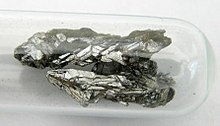 Type: Essential Mineral
Type: Essential Mineral
Periodic Element: (As)
RDA: The average person’s intake is about 10–50 µg/day. 10 parts per billion (ppb) Acceptable amount in drinking water according to World Health Organization.
Importance- To Body:
Toxin at high levels.
Some evidence indicates that arsenic is an essential trace mineral in birds (chickens), and in mammals (rats, hamsters, and goats). However, the biological function is not known.
Distribution- In Body:
The organs of the body that are usually affected by arsenic poisoning are the lungs, skin, kidneys, and liver.
Excess Effects:
headaches, confusion, severe diarrhea, drowsiness developing into convulsions, leukonychia striata – Mees’s lines, or Aldrich-Mees’s lines, diarrhea, vomiting, vomiting blood, blood in the urine, cramping muscles, hair loss, stomach pain and more convulsions.
Arsenic has been linked to reproductive epigenetic changes, heritable changes in gene expression that occur without changes in DNA sequence. These include DNA methylation, histone modification, and RNA interference.
Deficiency Effects:
None listed
Sources Food:
Leafy Vegetables, Rice, Apple Juice, Grape Juice, Mushrooms, Seafood
Values about 1000 µg are not unusual following consumption of fish or mushrooms, but there is little danger in eating fish because this arsenic compound is nearly non-toxic.
Sources Environmental/Geographic:
Naturally occurring sources of human exposure include volcanic ash, weathering of minerals and ores, and mineralized groundwater. Arsenic is also found in food, water, soil, and air. Arsenic is absorbed by all plants, but is more concentrated in leafy vegetables, rice, apple and grape juice, and seafood. An additional route of exposure is inhalation of atmospheric gases and dusts.
Supplemental information:
 |
|||||||||||||||||||||||||||||
| General properties | |||||||||||||||||||||||||||||
|---|---|---|---|---|---|---|---|---|---|---|---|---|---|---|---|---|---|---|---|---|---|---|---|---|---|---|---|---|---|
| Pronunciation |
|
||||||||||||||||||||||||||||
| Allotropes | grey (most common), yellow, black | ||||||||||||||||||||||||||||
| Appearance | metallic grey | ||||||||||||||||||||||||||||
| Standard atomic weight (Ar, standard) | 74.921595(6) | ||||||||||||||||||||||||||||
| Arsenic in the periodic table | |||||||||||||||||||||||||||||
|
|||||||||||||||||||||||||||||
| Atomic number (Z) | 33 | ||||||||||||||||||||||||||||
| Group | group 15 (pnictogens) | ||||||||||||||||||||||||||||
| Period | period 4 | ||||||||||||||||||||||||||||
| Element category | metalloid | ||||||||||||||||||||||||||||
| Block | p-block | ||||||||||||||||||||||||||||
| Electron configuration | [Ar] 3d10 4s2 4p3 | ||||||||||||||||||||||||||||
|
Electrons per shell
|
2, 8, 18, 5 | ||||||||||||||||||||||||||||
| Physical properties | |||||||||||||||||||||||||||||
| Phase at STP | solid | ||||||||||||||||||||||||||||
| Sublimation point | 887 K (615 °C, 1137 °F) | ||||||||||||||||||||||||||||
| Density (near r.t.) | 5.727 g/cm3 | ||||||||||||||||||||||||||||
| when liquid (at m.p.) | 5.22 g/cm3 | ||||||||||||||||||||||||||||
| Triple point | 1090 K, 3628 kPa | ||||||||||||||||||||||||||||
| Critical point | 1673 K, ? MPa | ||||||||||||||||||||||||||||
| Heat of fusion | grey: 24.44 kJ/mol | ||||||||||||||||||||||||||||
| Heat of vaporization | 34.76 kJ/mol (?) | ||||||||||||||||||||||||||||
| Molar heat capacity | 24.64 J/(mol·K) | ||||||||||||||||||||||||||||
Vapor pressure
|
|||||||||||||||||||||||||||||
| Atomic properties | |||||||||||||||||||||||||||||
| Oxidation states | 5, 4, 3, 2, 1, −1, −2, −3 |
||||||||||||||||||||||||||||
| Electronegativity | Pauling scale: 2.18 | ||||||||||||||||||||||||||||
| Ionization energies |
|
||||||||||||||||||||||||||||
| Atomic radius | empirical: 119 pm | ||||||||||||||||||||||||||||
| Covalent radius | 119±4 pm | ||||||||||||||||||||||||||||
| Van der Waals radius | 185 pm | ||||||||||||||||||||||||||||
|
|||||||||||||||||||||||||||||
| Miscellanea | |||||||||||||||||||||||||||||
| Crystal structure | rhombohedral | ||||||||||||||||||||||||||||
| Thermal expansion | 5.6 µm/(m·K) (at r.t.) | ||||||||||||||||||||||||||||
| Thermal conductivity | 50.2 W/(m·K) | ||||||||||||||||||||||||||||
| Electrical resistivity | 333 nΩ·m (at 20 °C) | ||||||||||||||||||||||||||||
| Magnetic ordering | diamagnetic | ||||||||||||||||||||||||||||
| Magnetic susceptibility | −5.5·10−6 cm3/mol | ||||||||||||||||||||||||||||
| Young's modulus | 8 GPa | ||||||||||||||||||||||||||||
| Bulk modulus | 22 GPa | ||||||||||||||||||||||||||||
| Mohs hardness | 3.5 | ||||||||||||||||||||||||||||
| Brinell hardness | 1440 MPa | ||||||||||||||||||||||||||||
| CAS Number | 7440-38-2 | ||||||||||||||||||||||||||||
| History | |||||||||||||||||||||||||||||
| Discovery | c. 800 CE | ||||||||||||||||||||||||||||
| Main isotopes of arsenic | |||||||||||||||||||||||||||||
|
|||||||||||||||||||||||||||||
Arsenic is a chemical element with symbol As and atomic number 33. Arsenic occurs in many minerals, usually in combination with sulfur and metals, but also as a pure elemental crystal. Arsenic is a metalloid. It has various allotropes, but only the gray form is important to industry.
The primary use of metallic arsenic is in alloys of lead (for example, in car batteries and ammunition). Arsenic is a common n-type dopant in semiconductor electronic devices, and the optoelectronic compound gallium arsenide is the second most commonly used semiconductor after doped silicon. Arsenic and its compounds, especially the trioxide, are used in the production of pesticides, treated wood products, herbicides, and insecticides. These applications are declining, however.
A few species of bacteria are able to use arsenic compounds as respiratory metabolites. Trace quantities of arsenic are an essential dietary element in rats, hamsters, goats, chickens, and presumably many other species, including humans. However, arsenic poisoning occurs in multicellular life if quantities are larger than needed. Arsenic contamination of groundwater is a problem that affects millions of people across the world.
The United States' Environmental Protection Agency states that all forms of arsenic are a serious risk to human health. The United States' Agency for Toxic Substances and Disease Registry ranked arsenic as number 1 in its 2001 Priority List of Hazardous Substances at Superfund sites. Arsenic is classified as a Group-A carcinogen.



